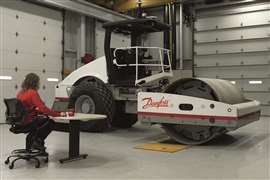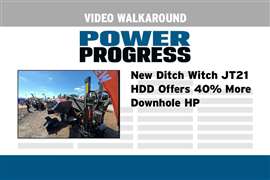Read this article in Français Deutsch Italiano Português Español
Fluid power suppliers leap industry hurdles
15 May 2025
In Part 2 of this series, we looked at the challenges and opportunities ahead for mobile fluid power
In the April 2025 issue of Power Progress, we looked at trends that are impacting fluid power in mobile equipment applications. In part two of this series, we shift to exploring the hurdles the fluid power sector is encountering and how suppliers are evolving to ensure they can continue to meet OEM customer needs now and into the foreseeable future.
We asked each of the following industry experts to share their perspective on three key questions:
- Daniel Winter, president, Danfoss Power Solutions
- Corey Quinnell, vice president of Engineering, Husco
- Russ Schneidewind, director of Business Development, HydraForce
Q: What are some of the biggest hurdles your company, and others, face in meeting OEM needs today? How is the company evolving to meet those needs?
Corey Quinnell, Husco: Diverse electrification strategies – Each OEM has a unique approach to electrification, requiring flexible and scalable solutions that integrate with various powertrain and control architectures.
System validation strategy – The shift toward electrohydraulic and smart control systems introduces new challenges in software integration, performance tuning, and system validation.
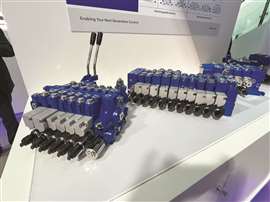 Husco’s MX Range of pressure-compensated load sense (PCLS/LUDV) valves for EH integration is designed to provide greater flexibility and productivity in a compact space. (Photo: Becky Schultz)
Husco’s MX Range of pressure-compensated load sense (PCLS/LUDV) valves for EH integration is designed to provide greater flexibility and productivity in a compact space. (Photo: Becky Schultz)
Supply chain and lead time pressures – Global supply chain disruptions and fluctuating material availability impact the ability to deliver components on time and at scale.
Stricter efficiency and sustainability demands – OEMs face increasing pressure to comply with stricter emissions regulations and energy efficiency standards, driving suppliers to develop highly efficient, low-energy solutions — with sustainability considerations extending throughout the entire supply chain, from raw material sourcing to final production.
The transition to electrohydraulic and hybrid powertrains introduces new engineering challenges, requiring seamless integration of hydraulics with electronic controls and software. One common challenge we encounter is that new innovations often have different response characteristics, requiring refined tuning strategies to maintain stability that the end user expects.
Russ Schneidewind, Hydraforce: My experience is that the OEMs want to have a certain degree of control, because they want to be able to differentiate their machines from the competition. And at the same time, they don’t want to be locked in or beholden to one supplier... If they buy a full electrohydraulic system, say, from one supplier, they sometimes perceive that as being a lot of risk, especially with the recent supply chain issues that we had...
There’s going to be some level of subsystem reliance on certain suppliers. As an example, for certain functions on a machine, they may integrate an electrohydraulic system from a supplier; and then on another function, they may say, “Well, this supplier is better at that function, so I’m going to integrate that function from that supplier,” so they don’t become so dependent on one supplier.
In that electrohydraulic subsystem, that includes a controller and there’s going to be communication from some real main controller on the machine. They’ve already got CAN networks and Ethernet networks they can use on machines to communicate to these subsystems, and that’s really how they’ll differentiate their machine. They’ll still control everything, but they’re not going to control it to the degree maybe that they do today.
I think that’s actually beneficial for the OEMs. They probably will get a better end product that way because it lets experts control the function that those experts are good at controlling within their subsystem, and then [the OEMs can] control what they’re good at controlling, which is the whole machine. And they can offer benefits to their customers, depending upon what benefits they feel their customers will need...
The biggest hurdle is the acceptance of a different architecture for the hydraulic system, electrohydraulic system. Sometimes it’s related to cost, because adding more sensors, integrating more electronics, it’s going to be more costly. But in the end, the way the fluid power industry has to adapt is we have to be able to look at the whole system, and we have to be able to mitigate the cost increase from a component level and at the same time by demonstrating higher return on that maybe higher cost to the OEM customer... It really takes a lot more collaboration.
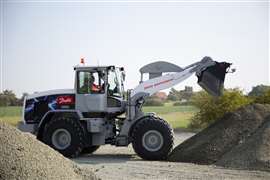 Electrics have replaced hydraulics in some lower power and rotary applications, but in the near term, linear actuation will remain largely hydraulic in high-power applications, such as this wheel loader. (Photo: Danfoss Power Solutions)
Electrics have replaced hydraulics in some lower power and rotary applications, but in the near term, linear actuation will remain largely hydraulic in high-power applications, such as this wheel loader. (Photo: Danfoss Power Solutions)
Daniel Winter, Danfoss: OEMs are increasingly seeking optimized system solutions rather than just components, and this shift is transforming the way we work with our partners. While some OEMs prefer to source individual components and integrate them themselves, others are embracing fully integrated solutions that deliver higher efficiency and productivity.
At Danfoss, we’re evolving alongside this trend, adopting a more collaborative approach to ensure our customers get the best system-level solutions.
Additionally, we recognize that pricing new technologies can be a challenge, but we believe that with the right support — through regulations and economic accelerators — we can bring truly disruptive technologies to market.
Q: How has your company’s product mix evolved to fit changing customer applications and requirements?
Winter, Danfoss: Hydraulic components have been part of the Danfoss portfolio for decades. With the acquisition of Eaton Hydraulics in 2021, we added fluid conveyance and industrial products, creating the broadest portfolio on the market. Most of our hydraulic product developments, though, are handled in-house by our talented team of 1,600 engineers.
Editron, our electrification division, was built on acquisitions, including Visedo in 2017, AXCO-Motors in 2018, and UQM Technology in 2019. Through these acquisitions, we expanded our portfolio to include electric motors, converters, inverters and subsystems, enabling us to add electric solutions as a key competency. Today, we are a leading manufacturer of hybrid and fully electric drivetrains for the off-highway, on-highway and marine markets, and our Editron division is our fastest growing business.
Having both hydraulics and electric solutions in our portfolio enables us to meet customers where they are on their journeys and provide them with the solutions that make the most sense for each of their platforms.
Another area of strategic importance for Danfoss is our autonomy business, which we’ve built in-house and through strategic partnerships. The business ties together hardware, software and engineering services to help OEMs develop autonomous machinery. We work with OEMs from concept to production, supporting full vehicle development.
Quinnell, Husco: Husco is leading in the development of intelligent fluid control technologies that improve efficiency and precision while integrating with electrified platforms. There is an opportunity to integrate additional components, particularly electrical, into our traditionally hydromechanical control valves. This not only enhances our product portfolio but also opens doors to new market opportunities.
The integration of electronic valves not only enhances product performance but also improves manufacturing efficiency, enabling quicker testing, streamlined sub-assembly verification and enhanced quality control.
Husco continues to innovate by balancing the strengths of hydraulics with emerging electrification trends, ensuring our solutions meet the evolving needs of OEMs while maintaining the power, durability and reliability that hydraulics provide.
Husco has always emphasized the flexibility of our valve platforms, whether manual, pilot or electrohydraulic (EH) controlled. This adaptability has enabled us to meet the diverse needs of our OEMs.
Recently, we have seen a shift in demand, with many new valve configurations being electrohydraulic rather than the traditional mix of pilot or manual control. This reflects the industry’s growing focus on automation, efficiency, and smart system integration.
Husco invests heavily in R&D, advanced simulation tools and rapid prototyping to develop next-generation hydraulic and mechatronic solutions that align with evolving OEM requirements.
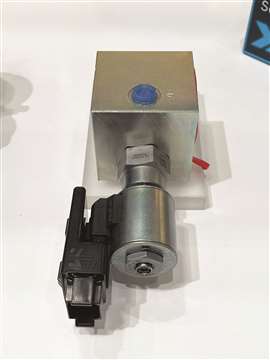 The HydraForce EHBL Digital Boom Control with HF-Impulse 2.0. (Photo: Becky Schultz)
The HydraForce EHBL Digital Boom Control with HF-Impulse 2.0. (Photo: Becky Schultz)
We work closely with leading equipment manufacturers to develop customized solutions that integrate seamlessly into their unique applications. We like to say we are an extension of our customers’ engineering team.
Our state-of-the-art manufacturing capabilities allow for rapid adaptation, including flexible production lines, automated testing and advanced sub-assembly verification, particularly for our growing portfolio of electronic control valves.
We collaborate closely with strategic suppliers to ensure material availability, flexible production scaling and rapid response to evolving OEM needs, allowing us to maintain our commitment to customizable, high-performance solutions.
Schneidewind, Hydraforce: We have one new product that we’ve come out with – it’s a system architecture, and it really addresses a problem in regard to uptime or availability of a machine.
Traditionally, what will happen on an excavator is, if they’re doing any sort of craning operation or they’re holding something up in the air, they have to install a device called a boom lock valve or a hose burst valve… If they put traditional hydraulic boom lock valves on, that excavator then becomes sort of isolated to craning operations or elevated load holding operations. When they try to use that excavator in a digging function, it’s just not as operator friendly, it’s not as smooth, it’s not working as well as it would have before. So, they have to have more machines, they have less flexibility, and they have less availability and uptime of certain machines. It’s an inefficiency for a dealer or a rental company.
What Hydraforce developed is an EHBL, which is an electrohydraulic boom lock valve. That valve is similar to the hydraulic boom lock valve except it’s controlled by a small controller, some pressure sensors and an electro-proportional valve [which] all work together with the controller to understand when the boom may be in a circumstance where it needs to lock. It does the same function as the traditional hydraulic boom lock valve, but it also can be removed completely from the system so that the machine is able to do its traditional excavating operation.
We partnered with a company, HKX. They’re an aftermarket company that puts together these solutions and kits and puts them on excavators even after they’re in the field. They found that their customers can use that machine in multiple applications, whether it’s craning or traditional excavating, so they get more uptime out of that machine as a result. And they’re seeing that the customers are really satisfied with that.
So that’s an example where we went a non-traditional route to introduce a new technology that’s really going to be needed in the future for those OEMs. And you have to think that as they start to see customers enjoying that new type of architecture, that new type of system, that they would start to say maybe we should offer this as either an optional or a standard product moving forward for our machines.
Q: What do you anticipate lies ahead for your company, and for the mobile fluid power industry as a whole, in the next three to five years?
Quinnell, Husco: Over the next three to five years, the mobile fluid power industry will continue evolving, driven by electrification, automation, efficiency and sustainability demands. Husco is well-positioned to lead this transformation by advancing electrohydraulic technologies, expanding our manufacturing capabilities, and continue to strengthen our OEM partnerships.
Schneidewind, Hydraforce: We’re focusing on the integration of more electronics that fit our niche, that compact solution... We’re looking at some smaller controllers that are compact, easy to use. We have a new graphic user interface that we call HF-Impulse 2.0 that makes it easy for customers to either configure a certain function block or to design and develop their own programs.
We make it so that it can be utilized in this subsystem concept… and we’re also integrating a lot more electronics into the hydraulic components, like position sensors in the cartridge valve and in the compact directional valves, trying to be able to monitor the position of a spool, as an example, to give that information back to the control system so they can have better control of the function.
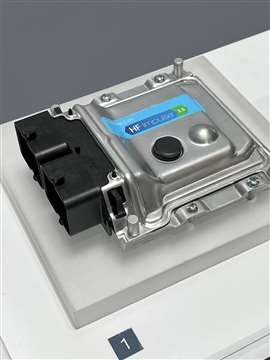 HF-Impulse 2.0 Configuration and Programming Software allows customers to configure a certain function block or to design and develop their own programs. (Photo: Becky Schultz)
HF-Impulse 2.0 Configuration and Programming Software allows customers to configure a certain function block or to design and develop their own programs. (Photo: Becky Schultz)
[As part of Bosch Rexroth}, when a customer has certain requirements, we can now meet or address those requirements that maybe as a standalone brand we couldn’t meet before. Now we have the ability to custom engineer and come up with the right solution, whether that be a hybrid solution or more traditional like stack valves.
Our goal is to make [our solutions] as powerful as possible – able to handle high pressures and flows within our range and our niche – in as small as possible package. That’s what the hybrid opportunity allows. On compact power units, in some cases that’s an older technology. But if you consider utilizing it differently, for instance, as a way to generate extension of a cylinder in the lift function and then recover energy on the down function, that’s another opportunity for us for the future. Whereas in the past, when HydraForce was not part of the Bosch Rexroth organization, we really just focused on cartridge valves and HICs.
The other thing that we’re good at is to integrate hydraulic circuits in those compact power units so we can make a really compact, whole solution that includes multiple functions, rather than just maybe one or two.
We’re also looking at other things like telematics and over-the-air update capabilities, because we think that’s going to be an important feature, especially of these subsystems. If we’re able to make necessary updates remotely, we can add value that a customer doesn’t have to worry about. Or we can offer an option that’s functionally there on the machine already where they can simply add an application software program that would be an upgrade to that machine.
One of the threats that’s coming from outside our industry is electromechanical rotary actuation. Electromechanical hydraulics still has an advantage from a compact power standpoint, but from an efficiency standpoint, we need to step up… In order to be more efficient, that integration of more electronics, more sensors and proficiency in the application software is going to be key.
Winter, Danfoss: We believe the continued focus on efficiency will lead to the development of more system solutions. Reaching the highest levels of efficiency requires optimization at the systems level.
As a supplier, we know where our products run most efficiently, and we can design control algorithms to operate at those peak points. At Danfoss, we’re developing packaged, validated system solutions that deliver higher efficiency as well as greater productivity. Our customers are taking notice, and we expect interest in and further development and commercialization of such solutions to increase in the next few years.
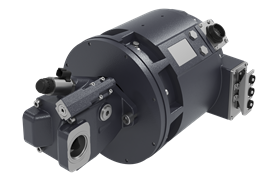 eHydraulic solutions, like this Danfoss eHydraulic Power Module, are a focus for development in the coming years. Such components are designed specifically for electric vehicles. (Photo: Danfoss Power Solutions)
eHydraulic solutions, like this Danfoss eHydraulic Power Module, are a focus for development in the coming years. Such components are designed specifically for electric vehicles. (Photo: Danfoss Power Solutions)
We also anticipate significant advancements in and deployment of eHydraulic solutions, coupled with alternative system architectures. eHydraulics, or electric motor-driven hydraulics, are components and systems designed specifically for electric vehicles. Our engineers are fielding near-daily inquiries and working closely with our customers on hydraulic design and optimization for electric machines, and we have several exciting projects underway.
Emerging legislation will continue to challenge OEMs and suppliers to create more efficient, more recyclable solutions. It’s early days today, but it will pick up. We see sustainability shaping hydraulic systems towards increasing levels of efficiency and circularity in the years to come, which aligns well with our business… We’ll continue to collaborate with our customers to lead in solutions for decarbonization and circularity.
To effectively support our customers worldwide, we recognize the need for increased resilience in our operations. This means expanding and optimizing our global footprint to ensure that we can meet the growing demand for mobile fluid power solutions globally. By enhancing our presence across various regions and strengthening our supply chain, we can offer more localized, timely and tailored support, ensuring that our customers can rely on us regardless of their location.
As the digital landscape continues to evolve, we understand the importance of investing in digital customer engagement. By continually improving our systems, processes and tools, we are enhancing our ability to provide seamless support through digital channels.
This investment will allow us to better address customer queries, resolve issues more efficiently and streamline transactions, ensuring that our customers can easily access the information and solutions they need, whenever they need them. This shift not only boosts customer satisfaction but also aligns with the increasing trend of digital transformation across industries.
POWER SOURCING GUIDE
The trusted reference and buyer’s guide for 83 years
The original “desktop search engine,” guiding nearly 10,000 users in more than 90 countries it is the primary reference for specifications and details on all the components that go into engine systems.
Visit Now
STAY CONNECTED




Receive the information you need when you need it through our world-leading magazines, newsletters and daily briefings.
CONNECT WITH THE TEAM










